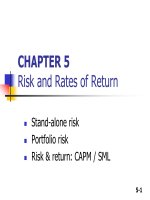New Products Management - CHAPTER 5 PROBLEMBASED IDEATION: FINDING AND SOLVING CUSTOMERS’ PROBLEMS docx
Bạn đang xem bản rút gọn của tài liệu. Xem và tải ngay bản đầy đủ của tài liệu tại đây (677.32 KB, 14 trang )
CHAPTER 5
CHAPTER 5
PROBLEM-BASED IDEATION: FINDING
PROBLEM-BASED IDEATION: FINDING
AND SOLVING CUSTOMERS’ PROBLEMS
AND SOLVING CUSTOMERS’ PROBLEMS
McGraw-Hill/Irwin
Copyright ©2006 The McGraw-Hill Companies, Inc. All right reserved.
Problem-Based Concept Generation
Problem-Based Concept Generation
Figure 5.1
Problem Analysis: General Procedure
Problem Analysis: General Procedure
1. Determine product or activity
category for study.
2. Identify heavy users.
3. Gather set of problems associated
with product category.
Avoid “omniscient proximity” rate
importance of benefits and levels of
satisfaction.
4. Sort and rank the problems according
to severity or importance.
Problem Analysis Applied to the Cell Phone
Problem Analysis Applied to the Cell Phone
Keeping the unit clean.
Breaks when I drop it.
Battery doesn’t stay
charged long enough.
Finding it in dark.
Battery dies in mid-
conversation.
Who “out there” hears me?
Dropped calls.
Looking up numbers.
Voice fades in and out.
Hard to hold.
Health risks?
Can’t cradle between ear
and shoulder.
Antenna breaks off.
Flip cover breaks off.
Disruptive instrument.
Can’t see facial/body
language.
Rings too loud/too soft.
Wrong numbers.
Fear of what ringing
might be for.
Figure 5.2
The Bothersomeness Technique of Scoring
The Bothersomeness Technique of Scoring
Problems
Problems
Figure 5.3
List of pet owners' problems:
A
Problem Occurs
Frequently
B
Problem is
Bothersome
A x B
Need constant feeding 98% 21% .21
Get fleas 78 53 .41
Shed hairs 70 46 .32
Make noise 66 25 .17
Have unwanted babies 44 48 .21
Problem Analysis: Sources and
Problem Analysis: Sources and
Methodologies
Methodologies
Experts
Published Sources
Contacts with Your Business Customers
or Consumers
Interviewing
Focus groups
Observation of product in use
Role playing
Typical Questions for Problem Analysis
Typical Questions for Problem Analysis
Focus Groups
Focus Groups
What is the real problem here – what if the
product category did not exist?
What are current attitudes and behaviors of
focus group members toward the product
category?
What product attributes and benefits do the
focus group members want?
What are their dissatisfactions, problems, and
unfilled needs?
What changes occurring in their lifestyles are
relevant to the product category?
Observation and Role Playing in
Observation and Role Playing in
Problem Analysis
Problem Analysis
Carmakers send their designers out to parking
lots to watch people and how they interact with
their cars (Ford called this “gorilla research”).
Honda got insights as to how large the
passenger compartments of their SUVs should
be by observing U.S. families.
Bausch and Lomb generated ideas on making
contact lenses more comfortable by getting
pairs of executives to act out skits in which they
played the eyeball and the contact lens.
Scenario Analysis
Scenario Analysis
“Extending” vs. “leaping”
Using seed trends for an “extend“
scenario
Techniques:
Follow “trend people”/”trend areas”
“Hot products”
Prediction of technological changeover
Cross-impact analysis
Relevance Tree Form of Dynamic Leap
Relevance Tree Form of Dynamic Leap
Scenario
Scenario
Figure 5.4
Wild Card Events and Their
Wild Card Events and Their
Consequences
Consequences
No-Carbon Policy: Global warming may cause
governments to put high taxes on fossil fuels, shifting
demand to alternative sources of energy. This changes
the allocation of R&D investment toward alternative
energy, possibly causes new “energy-rich” nations to
emerge, and ultimately may lead to a cleaner
environment for everyone.
Altruism Outbreak: This is the “random acts of
kindness” movement – solve social problems rather than
leaving it up to the government. Schools and other
institutions will revive due to community actions, and
perhaps inner cities would be revitalized.
Cold Fusion: If a developing country perfects free
energy, it becomes prosperous overnight. It gains
further advantages by becoming an energy exporter.
Figure 5.6
Solving the Problem
Solving the Problem
Group Creativity Methods/Brainstorming
Principles of Brainstorming:
Deferral of Judgment
Quantity Breeds Quality
Rules for a Brainstorming Session:
No criticism allowed.
Freewheeling the wilder the better.
Nothing should slow the session down.
Combination and improvement of ideas.
Brainstorming Techniques
Brainstorming Techniques
Brainstorming circle
Reverse brainstorming
Tear-down
Phillips 66 groups (buzz groups)
Delphi method
Electronic Brainstorming
Electronic Brainstorming
Supported by GSS (group support systems)
software.
Overcomes many drawbacks of brainstorming
(only one can talk at a time, fear of contributing,
“social loafing”).
Participants sit at networked terminals.
Contributions are projected on screen, and also
recorded (so no errors are made in transcription).
Can be done over multiple sites via computer
linkups or videoconferencing.
Can handle larger size groups (into the hundreds).









